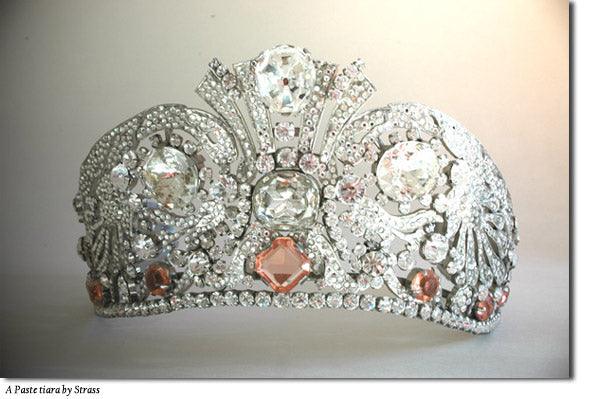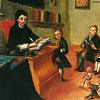Portrait Miniatures
"Oh, Elinor!" she cried, "I have such a secret to tell you about Marianne. I am sure she will be married to Mr Willoughby very soon."
"You have said so," replied Elinor, "almost every day since they first met on Highchurch Down; and they had not known each other a week, I believe, before you were certain that Marianne wore his picture round her neck; but it turned out to be only the miniature of our great uncle."
Sense and Sensibility

In 1761 King George III gave his bride a wedding gift of a tiny portrait miniature of himself. Little did he know he was inspiring a fashion. When the Queen posed for a full-size portrait wearing the miniature on a pearl bracelet, the fashionable of the day took note, and the fad took off.
The upper classes swarmed to have their own miniatures done, and a few artists became known for such work. Richard Cosway was possibly the most prolific and successful miniaturist, counting the Prince of Wales, among many others, as a patron.
Portrait miniatures were being produced all over Europe, but nothing paralleled the popularity it found in Britain, especially between around 1769 to 1830. In short, it was a favored Regency form of expression and decoration. The practice of making miniature portraits began as a way for monarchs and other members of the court to produce likenessess which could be given away, mostly for diplomatic purposes. Less costly than full portraits and much more portable, they were imminently practical in an age without photography. They soon became treasured as precious objects, however, and put in opulent settings of gold, pearls and ivory.
Their sizes ranged from as small as 1x1 and a quarter inch to 7x 4 with every variation in between. Most were oval, but there was variation in shape as well as their manner of being worn close to the body.

In addition to a bracelet, for instance, portrait miniatures were often worn as a necklace, on a watch fob, or as a brooch. During the Regency, it was no longer only royalty who commissioned them, but an increasing number of the middle class. The main reason for having or giving one away? To keep loved ones close at heart. What better way to remember one's love than by sporting the likeness of the beloved? Miniatures were especially popular with sailors who would be at Sea for years on end. Only think of the circumstances surrounding Captain Benwick's miniature Portrait in
Persuasion!
An interesting variation of portrait miniatures was the Lover's Eye--a tiny portrait of one whole eye! Miniscule and more intimate than a full portrait, the eye was considered the window to the soul--thus being given an eye likeness was a token of intimacy that "outranked" the usual miniature. In addition, even secret lovers could safely exchange these, since anonymity was guaranteed.

In 1786 the prince of Wales (the future Regent) paid five guineas for eye miniatures of himself and Mrs. Fitzherbert, which were encased in gold lockets. Later the prince had another eye miniature made and even one of his mouth, presumably to give to Mrs. Fitz. And before his death in 1830, though he had abandoned her in life, the King insisted upon being buried with the miniature of Mrs. Fitzherbert around his neck; in effect, close to his heart. The Duke of Wellington, to be safe, checked the corpse before burial. Sure enough, the miniature, set with diamonds, was there.
Other uses for the portrait miniature were as tools for grief and mourning, in which the deceased would be remembered as they were in life; or as statements of deep emotional states, such as melancholia, in which the subject would most likely rest his or her head on one hand. The sentimental usage of miniatures as love tokens or means of remembrance, however, is largely what spurred their popularity in the past, just as photos are wildly popular for such reasons today.

The miniatures' popularity peaked at about 1830 and then declined quickly with the advent of photography. The caliber of the artwork on them is no less superb than on larger works of art, and today they are museum pieces and heirlooms. Often these little works of sentiment are the only pictoral representation we have of historical figures, like Tom LeFroy, Jane Austen's first Love. Without Portrait Miniatures he would only be a name lost to history.
Linore Rose Burkard writes Inspirational Regency Romance as well as articles on Regency Life, Homeschooling, and Self-Improvement. She publishes a monthly eZine "Upon My Word!" (website). Ms. Burkard graduated from the City University of New York with a Magna Cum Laude degree in English Literature, and now lives in Ohio with her husband and five children.
 In addition to a bracelet, for instance, portrait miniatures were often worn as a necklace, on a watch fob, or as a brooch. During the Regency, it was no longer only royalty who commissioned them, but an increasing number of the middle class. The main reason for having or giving one away? To keep loved ones close at heart. What better way to remember one's love than by sporting the likeness of the beloved? Miniatures were especially popular with sailors who would be at Sea for years on end. Only think of the circumstances surrounding Captain Benwick's miniature Portrait in Persuasion!
An interesting variation of portrait miniatures was the Lover's Eye--a tiny portrait of one whole eye! Miniscule and more intimate than a full portrait, the eye was considered the window to the soul--thus being given an eye likeness was a token of intimacy that "outranked" the usual miniature. In addition, even secret lovers could safely exchange these, since anonymity was guaranteed.
In addition to a bracelet, for instance, portrait miniatures were often worn as a necklace, on a watch fob, or as a brooch. During the Regency, it was no longer only royalty who commissioned them, but an increasing number of the middle class. The main reason for having or giving one away? To keep loved ones close at heart. What better way to remember one's love than by sporting the likeness of the beloved? Miniatures were especially popular with sailors who would be at Sea for years on end. Only think of the circumstances surrounding Captain Benwick's miniature Portrait in Persuasion!
An interesting variation of portrait miniatures was the Lover's Eye--a tiny portrait of one whole eye! Miniscule and more intimate than a full portrait, the eye was considered the window to the soul--thus being given an eye likeness was a token of intimacy that "outranked" the usual miniature. In addition, even secret lovers could safely exchange these, since anonymity was guaranteed.
 In 1786 the prince of Wales (the future Regent) paid five guineas for eye miniatures of himself and Mrs. Fitzherbert, which were encased in gold lockets. Later the prince had another eye miniature made and even one of his mouth, presumably to give to Mrs. Fitz. And before his death in 1830, though he had abandoned her in life, the King insisted upon being buried with the miniature of Mrs. Fitzherbert around his neck; in effect, close to his heart. The Duke of Wellington, to be safe, checked the corpse before burial. Sure enough, the miniature, set with diamonds, was there.
Other uses for the portrait miniature were as tools for grief and mourning, in which the deceased would be remembered as they were in life; or as statements of deep emotional states, such as melancholia, in which the subject would most likely rest his or her head on one hand. The sentimental usage of miniatures as love tokens or means of remembrance, however, is largely what spurred their popularity in the past, just as photos are wildly popular for such reasons today.
In 1786 the prince of Wales (the future Regent) paid five guineas for eye miniatures of himself and Mrs. Fitzherbert, which were encased in gold lockets. Later the prince had another eye miniature made and even one of his mouth, presumably to give to Mrs. Fitz. And before his death in 1830, though he had abandoned her in life, the King insisted upon being buried with the miniature of Mrs. Fitzherbert around his neck; in effect, close to his heart. The Duke of Wellington, to be safe, checked the corpse before burial. Sure enough, the miniature, set with diamonds, was there.
Other uses for the portrait miniature were as tools for grief and mourning, in which the deceased would be remembered as they were in life; or as statements of deep emotional states, such as melancholia, in which the subject would most likely rest his or her head on one hand. The sentimental usage of miniatures as love tokens or means of remembrance, however, is largely what spurred their popularity in the past, just as photos are wildly popular for such reasons today.  The miniatures' popularity peaked at about 1830 and then declined quickly with the advent of photography. The caliber of the artwork on them is no less superb than on larger works of art, and today they are museum pieces and heirlooms. Often these little works of sentiment are the only pictoral representation we have of historical figures, like Tom LeFroy, Jane Austen's first Love. Without Portrait Miniatures he would only be a name lost to history.
The miniatures' popularity peaked at about 1830 and then declined quickly with the advent of photography. The caliber of the artwork on them is no less superb than on larger works of art, and today they are museum pieces and heirlooms. Often these little works of sentiment are the only pictoral representation we have of historical figures, like Tom LeFroy, Jane Austen's first Love. Without Portrait Miniatures he would only be a name lost to history.



